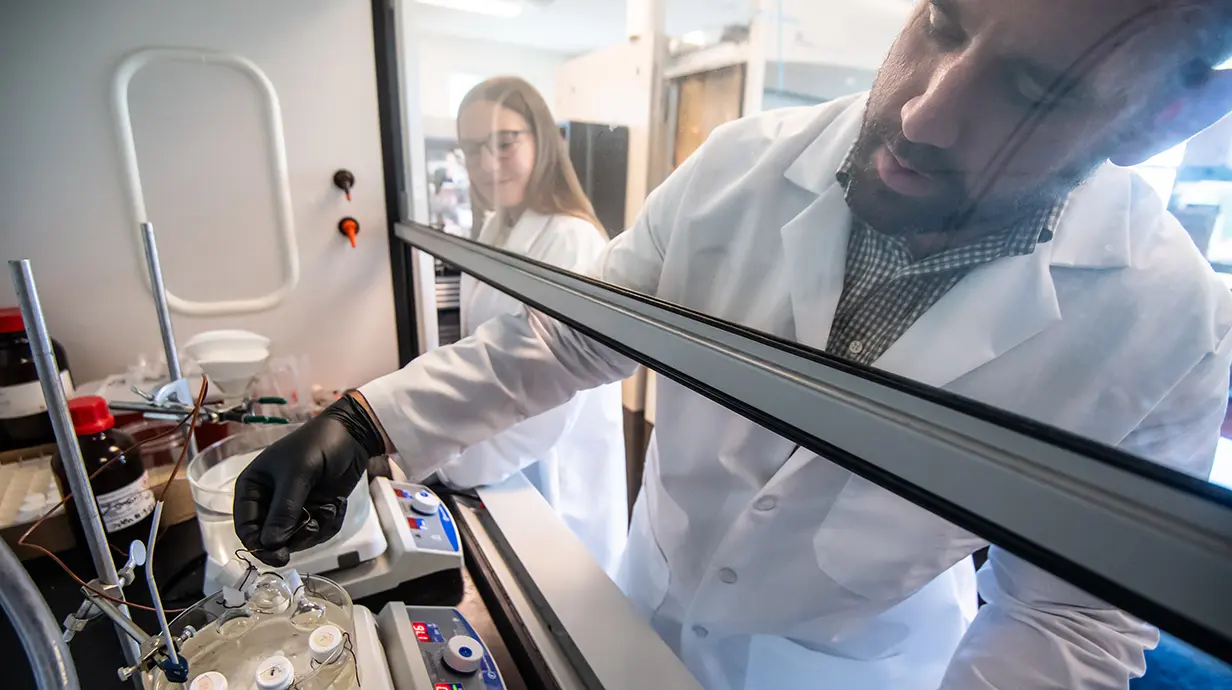Reviewed by Lexie CornerNov 21 2024
Recent research from the University of Mississippi, published in ACS Nano, suggests that a spoonful of sugar may aid in the absorption of medicine and potentially reduce the negative side effects of cancer treatment.
 Thomas Werfel (right), associate professor of biomedical engineering, has published an article that suggests cancer drug delivery can be improved by coating nanoparticles that contain the medication in a sugar-like substance called glycopolymer. Image Credit: Kevin Bain/Ole Miss Digital Imaging Services
Thomas Werfel (right), associate professor of biomedical engineering, has published an article that suggests cancer drug delivery can be improved by coating nanoparticles that contain the medication in a sugar-like substance called glycopolymer. Image Credit: Kevin Bain/Ole Miss Digital Imaging Services
Instead of using an actual spoonful of sugar, the researchers experimented with glycopolymers—polymers made from natural sugars like glucose—to coat small particles that deliver cancer-fighting medication directly to tumors. They found that glycopolymers help prevent proteins from binding to the nanoparticles, reducing the body’s immune response to the treatment.
As a result, the body is better able to respond to the treatment.
The real heart of the problem is that cancer drugs are incredibly toxic.
Thomas Werfel, Associate Professor, The University of Mississippi
Werfel added, “They have a very narrow therapeutic window, meaning that the dose at which they work is very close to the dose at which they become toxic. And so as soon as you get enough dose for it to get rid of the tumor, it is also causing all this toxicity, all these off-target effects that you don't want. Why is that happening? That is happening because a fraction of the cancer drug gets to the cancer–in most cases, well less than 1 %; over 99 % goes everywhere else in the body.”
Toxic medications spreading to other parts of the body can cause serious conditions such as leukemia, allergic reactions, and the development of new tumors. However, by delivering more cancer treatment directly to the tumor, these side effects could be minimized.
Werfel and Kenneth Hulugalla, a third-year doctoral student in biomedical engineering from Kandy, Sri Lanka, published their findings in the journal ACS Nano in October.
Nanoparticles, which are smaller than one-thousandth the width of a human hair, have shown promise as an alternative cancer treatment, delivering medications directly to tumors. However, proteins, especially those that trigger immune responses, tend to accumulate around the nanoparticles, causing the body to recognize the treatment as a foreign substance.
This immune response reduces the drug’s effectiveness.
PEG (polyethylene glycol) for the past 30 years has been the gold standard to shield these particles from that happening.
Kenneth Hulugalla, Doctoral Student, Department of Biomedical Engineering, University of Mississippi
When first used, the drug performs exceptionally well. However, after the initial exposure, the body's immune system can quickly recognize it as a foreign substance. Once this occurs, the drug is unable to reach the tumor and effectively work.
The researchers noted that glycopolymers do not face this issue.
Hulugalla added, “Our findings highlight that the nanoparticles we're using significantly reduce unwanted immune responses while dramatically enhancing drug delivery, both in cell and animal models. This research could be an important step towards developing more effective cancer treatments.”
Werfel and Hulugalla tested glycopolymer-coated nanoparticle therapies in mice with breast cancer and found that the glycopolymer treatment delivered more nanoparticles to the tumors than a PEG-based particle.
The next phase of their research will involve loading the nanoparticles with medication and ensuring that the treatment remains effective against cancer.
“One aspect of what we want to do long term is not just study this in a defensive way, but also an offensive way. If we think about what we have looked at here, we have seen that the glycopolymers stimulate the immune system less. So, the particles stay in the body longer. They get to the tumor better. That is great,” Werfel added.
He concluded, “The other thing people have been working at for a long time is, how can we actively target the tumor? What specific signatures can we use to force more of the particle to accumulate, or more of the drug to accumulate at the tumor? That is at the forefront of our mindset for next steps.”
Journal Reference:
Hulugalla, K. et. al. (2024) Glycopolymeric Nanoparticles Enrich Less Immunogenic Protein Coronas, Reduce Mononuclear Phagocyte Clearance, and Improve Tumor Delivery Compared to PEGylated Nanoparticles. ACS Nano. doi.org/10.1021/acsnano.4c08922